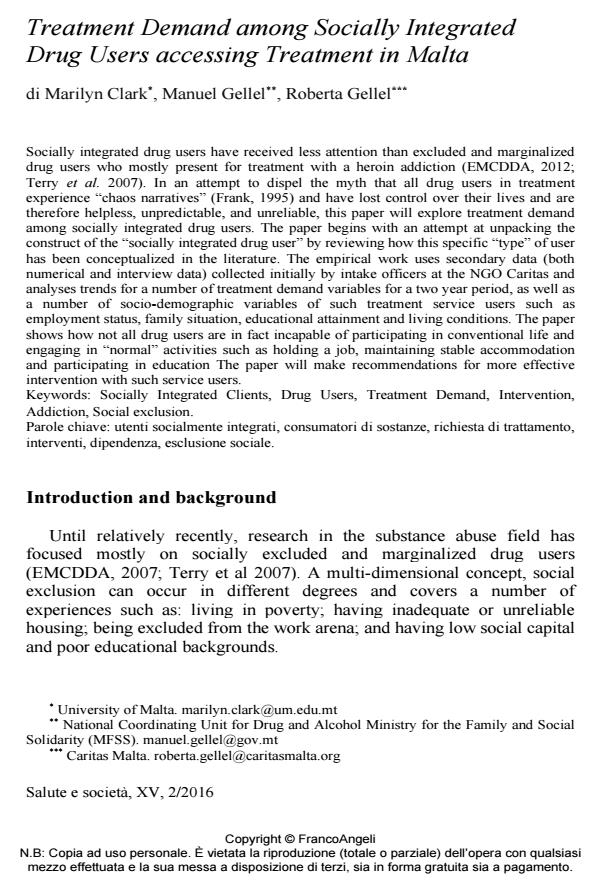Treatment Demand among Socially Integrated Drug Users accessing Treatment in Malta
Titolo Rivista SALUTE E SOCIETÀ
Autori/Curatori Marilyn Clark, Manuel Gellel, Roberta Gellel
Anno di pubblicazione 2016 Fascicolo 2016/2
Lingua Inglese Numero pagine 23 P. 150-172 Dimensione file 1338 KB
DOI 10.3280/SES2016-002011
Il DOI è il codice a barre della proprietà intellettuale: per saperne di più
clicca qui
Qui sotto puoi vedere in anteprima la prima pagina di questo articolo.
Se questo articolo ti interessa, lo puoi acquistare (e scaricare in formato pdf) seguendo le facili indicazioni per acquistare il download credit. Acquista Download Credits per scaricare questo Articolo in formato PDF

FrancoAngeli è membro della Publishers International Linking Association, Inc (PILA)associazione indipendente e non profit per facilitare (attraverso i servizi tecnologici implementati da CrossRef.org) l’accesso degli studiosi ai contenuti digitali nelle pubblicazioni professionali e scientifiche
Socially integrated drug users have received less attention than excluded and marginalized drug users who mostly present for treatment with a heroin addiction (EMCDDA, 2012; Terry et al. 2007). In an attempt to dispel the myth that all drug users in treatment experience "chaos narratives" (Frank, 1995) and have lost control over their lives and are therefore helpless, unpredictable, and unreliable, this paper will explore treatment demand among socially integrated drug users. The paper begins with an attempt at unpacking the construct of the "socially integrated drug user" by reviewing how this specific "type" of user has been conceptualized in the literature. The empirical work uses secondary data (both numerical and interview data) collected initially by intake officers at the NGO Caritas and analyses trends for a number of treatment demand variables for a two year period, as well as a number of socio-demographic variables of such treatment service users such as employment status, family situation, educational attainment and living conditions. The paper shows how not all drug users are in fact incapable of participating in conventional life and engaging in "normal" activities such as holding a job, maintaining stable accommodation and participating in education The paper will make recommendations for more effective intervention with such service users.
Parole chiave:Utenti socialmente integrati, consumatori di sostanze, richiesta di trattamento, interventi, dipendenza, esclusione sociale.
Marilyn Clark, Manuel Gellel, Roberta Gellel, Treatment Demand among Socially Integrated Drug Users accessing Treatment in Malta in "SALUTE E SOCIETÀ" 2/2016, pp 150-172, DOI: 10.3280/SES2016-002011